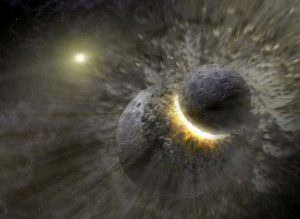
Scientists have long believed that the moon formed from debris created when a Mars-sized object crashed into Earth about 4.5 billion years ago. But there's one very big problem with this so-called giant impact hypothesis.
If the moon indeed formed from the collision between Earth and another object, why is the moon a near chemical match to our planet? Shouldn't it contain chemically distinct remnants of that other object too?
"In terms of composition, the Earth and moon are almost twins, their compositions differing by at most few parts in a million," Dr. Alessandra Mastrobuono-Battisti, an astrophysicist at the Israel Institute of Technology in Haifa, told Space.com. "This contradiction has cast a long shadow on the giant-impact model."
Finally, a new study conducted by an international team of scientists -- including Mastrobuono-Battisti -- offers a way to explain away this problem.
Previously, scientists believed that the likelihood that Earth and its impactor had similar makeups was only around 1 percent. But the new research ups those odds to 20-40 percent.
For the research, the team analyzed data from the computer simulations of 40 artificial solar systems to examine how often planets are similar to big objects that hit them, Smithsonian Magazine reported.
It turned out that since many planets and their impactors form at similar distances from the sun, they had similar compositions -- similar enough to account for the resemblances found between Earth and the moon.
"On average, impactors are more similar to the planets they impact compared with different planets in the same system,” Mastrobuono-Battisti told Discovery News. “Our study was the first to reconsider this issue, now exploring it with large data and... wide range of models."
The study was published online in the journal Nature on April 9.
Link:
http://www.huffingtonpost.com/2015/04/09/how-moon-formed-solved_n_7027700.html

No comments:
Post a Comment